Modelling of Effective Thermal Conductivity of Composites Filled with Core-Shell Fillers
Abstract
1. Introduction
2. Materials and Methods
2.1. Model of Thermal Conductivity
- Calculation of the effective thermal conductivity of the core-shell filler grain.
- Calculation of the thermal conductivity of the matrix-filler composite with the filler of the given effective thermal conductivity.
2.1.1. Effective Thermal Conductivity of Coated Filler
2.1.2. Model of Thermal Conductivity for Fixed Size of Core-Shell Grain
- Limiting filler concentration corresponding to the maximally packed filler,
- Parameter A depending on the shape, positioning, and orientation of the filler grains.
- The filler grain shape, mainly the aspect ratio of the filler grains, where is its largest dimension and the smallest one; the larger the aspect ratio, the larger .
- The randomness of positioning of the filler particles, both in the distances between the particles and in their mutual angular orientation.
2.1.3. Influence of Distributed Grain Size
2.2. Experimental
2.2.1. Sample Preparation Process
2.2.2. Measurements
3. Results and Discussion
3.1. Example of Core-Shell Filler Composite
3.1.1. Filler Morphology
3.1.2. Thermal Conductivity Measurements
3.2. Comparison of Experimental Results to the Developed Model
3.2.1. Silver-Coated Glass Beads
3.2.2. Boron-Nitride-Coated Cellulose Beads
4. Conclusions
- The Lewis-Nielsen model is an efficient tool to analyse the relation between the filler nature and its arrangement in the composite and the thermal conductivity; with the model developed in this paper, the applicability of this analysis is extended into the area of the core-shell fillers.
- The right approach when applying the Lewis-Nielsen model is to fit both its parameters, with the values limited to the allowed theoretical range, and not to apply the theoretical values as such, based only on the shape of the filler grains. This approach allows to better understand the thermal conductivity mechanisms in the particular example of the composite, such as the effects of aggregation of filler grains into larger structures or the influence of the processing characteristics.
- For spherical fillers, deviations of the parameter of the Lewis-Nielsen model from the theoretical values can be explained either by a broad distribution of sizes of the filler particles (leading to smaller ) or by aggregation of the particles, forming objects of higher aspect ratio (leading to larger ).
- An oriented mutual arrangement of densely packed h-BN platelets together with the highly anisotropic nature of thermal conductivity of h-BN can lead to an equal value of the parameter governing conductivity in the transverse and the longitudinal directions. This actually means an enhancement of the thermal conductivity in the direction perpendicular to the platelets compared to what would be expected from merely using the theoretical values of .
- The parameter is governed both by the deviation from sphericity of the filler (shape and aspect ratio) and by deviations from randomness of positions and angular orientation of the filler particles. This is the main weak point of the analysis applied, as these two effects cannot be fully distinguished from each other.
Author Contributions
Funding
Conflicts of Interest
References
- Bar-Cohen, A.; Watwe, A.A.; Prasher, R.S. Heat Transfer in Electronic Equipment. In Heat Transfer Handbook; Bejan, A., Kraus, A.D., Eds.; John Wiley & Sons, Inc.: Hoboken, NJ, USA, 2003; pp. 947–1027. [Google Scholar]
- Wong, C.; Bollampally, R. Comparative study of thermally conductive fillers for use in liquid encapsulants for electronic packaging. IEEE Trans. Adv. Packag. 1999, 22, 54–59. [Google Scholar] [CrossRef]
- Burger, N.; Laachachi, A.; Ferriol, M.; Lutz, M.; Toniazzo, V.; Ruch, D. Review of thermal conductivity in composites: Mechanisms, parameters and theory. Prog. Polym. Sci. 2016, 61, 28. [Google Scholar] [CrossRef]
- Chen, H.; Ginzburg, V.V.; Yang, J.; Yang, Y.; Liu, W.; Huang, Y.; Du, L.; Chen, B. Thermal conductivity of polymer-based composites: Fundamentals and applications. Prog. Polym. Sci. 2016, 59, 41–85. [Google Scholar] [CrossRef]
- Kashfipour, M.A.; Mehra, N.; Zhu, J. A review on the role of interface in mechanical, thermal, and electrical properties of polymer composites. Adv. Compos. Hybrid Mater. 2018, 1, 415–439. [Google Scholar] [CrossRef]
- Schmidt, C. Influence of the Kapitza resistance on the thermal conductivity of filled epoxies. Cryogenics 1975, 15, 17–20. [Google Scholar] [CrossRef]
- Kochetov, R.; Korobko, A.V.; Andritsch, T.; Morshuis, P.H.F.; Picken, S.J.; Smit, J.J. Modelling of the thermal conductivity in polymer nanocomposites and the impact of the interface between filler and matrix. J. Phys. D Appl. Phys. 2011, 44, 395401–395412. [Google Scholar] [CrossRef]
- Slack, G.A.; Tanzilli, R.A.; Pohl, R.O.; Vandersande, J.W. The Intrinsic Themal Conductivity of AlN. J. Phys. Chem. Solids 1987, 48, 641–647. [Google Scholar] [CrossRef]
- Jiang, P.; Qian, X.; Yang, R.; Lindsay, L. Anisotropic thermal transport in bulk hexagonal boron nitride. Phys. Rev. Mater. 2018, 2, 064005. [Google Scholar] [CrossRef]
- Maruzhenko, O.; Mamunya, Y.; Boiteux, G.; Pusz, S.; Szeluga, U.; Pruvost, S. Improving the thermal and electrical properties of polymer composites by ordered distribution of carbon micro- and nanofillers. Int. J. Heat Mass Transf. 2019, 138, 75–84. [Google Scholar] [CrossRef]
- Lee, G.-W.; Park, M.; Kim, J.; Lee, J.I.; Yoon, H.G. Enhanced thermal conductivity of polymer composites filled with hybrid filler. Compos. Part A Appl. Sci. Manuf. 2006, 37, 727–734. [Google Scholar] [CrossRef]
- Gaska, K.; Rybak, A.; Kapusta, C.; Sekula, R.; Siwek, A. Enhanced thermal conductivity of epoxy-matrix composites with hybrid fillers. Polym. Adv. Technol. 2014, 26, 26–31. [Google Scholar] [CrossRef]
- Rybak, A.; Jarosinski, L.; Gaska, K.; Kapusta, C. Graphene nanoplatelet-silica hybrid epoxy composites as electrical insulation with enhanced thermal conductivity. Polym. Compos. 2018, 39, E1682–E1691. [Google Scholar] [CrossRef]
- Krupa, I.; Boudenne, A.; Ibos, L. Thermophysical properties of polyethylene filled with metal coated polyamide particles. Eur. Polym. J. 2007, 43, 2443–2452. [Google Scholar] [CrossRef]
- Huang, L.; Zhu, P.; Li, G.; Lu, D.; Sun, R.; Wong, C. Core–shell SiO2@RGO hybrids for epoxy composites with low percolation threshold and enhanced thermo-mechanical properties. J. Mater. Chem. A 2014, 2, 18246–18255. [Google Scholar] [CrossRef]
- Eksik, O.; Bartolucci, S.F.; Gupta, T.; Fard, H.; Borca-Tasciuc, T.; Koratkar, N. A novel approach to enhance the thermal conductivity of epoxy nanocomposites using graphene core–shell additives. Carbon 2016, 101, 239–244. [Google Scholar] [CrossRef]
- Rybak, A.; Gaska, K. Functional composites with core–shell fillers: I. Particle synthesis and thermal conductivity measurements. J. Mater. Sci. 2015, 50, 7779–7789. [Google Scholar] [CrossRef]
- Rybak, A.; Gaska, K.; Kapusta, C.; Toche, F.; Salles, V. Epoxy composites with ceramic core-shell fillers for thermal management in electrical devices. Polym. Adv. Technol. 2017, 28, 1676–1682. [Google Scholar] [CrossRef]
- Nagaoka, S.; Jodai, T.; Kameyama, Y.; Horikawa, M.; Shirosaki, T.; Ryu, N.; Takafuji, M.; Sakurai, H.; Ihara, H. Cellulose/boron nitride core–shell microbeads providing high thermal conductivity for thermally conductive composite sheets. RSC Adv. 2016, 6, 33036–33042. [Google Scholar] [CrossRef]
- Tsekmes, I.A.; Kochetov, R.; Morshuis, P.H.F.; Smit, J.J. Modeling the thermal conductivity of polymeric composites based on experimental observations. IEEE Trans. Dielectr. Electr. Insul. 2014, 21, 412–423. [Google Scholar] [CrossRef]
- Ngo, I.-L.; Byon, C. An extensive study on enhancing the thermal conductivity of core–shell nanoparticle composites using finite element method. Int. J. Heat Mass Transf. 2016, 101, 147–155. [Google Scholar] [CrossRef]
- Lewis, T.B.; Nielsen, L.E. Dynamic mechanical properties of particulate-filled composites. J. Appl. Polym. Sci. 1970, 14, 1449–1471. [Google Scholar] [CrossRef]
- Russell, H.W. Principles of Heat Flow in Porous Insulators. J. Am. Ceram. Soc. 1935, 18, 1–5. [Google Scholar] [CrossRef]
- Okamoto, Y.; Ishida, H.A. New Theoretical Equation for Thermal Conductivity of Two-Phase Systems. J. Appl. Polym. Sci. 1999, 72, 1689–1697. [Google Scholar] [CrossRef]
- Agari, Y.; Uno, T. Estimation on thermal conductivities of filled polymers. J. Appl. Polym. Sci. 1986, 32, 5705–5712. [Google Scholar] [CrossRef]
- Progelhof, R.C.; Throne, J.L.; Ruetsch, R.R. Methods for predicting the thermal conductivity of composite systems: A review. Polym. Eng. Sci. 1976, 16, 615–625. [Google Scholar] [CrossRef]
- Droval, G.; Salagnac, P.; Glouannec, P.; Feller, J.-F. Thermal conductivity enhancement of electrically insulating syndiotactic poly(styrene) matrix for diphasic conductive polymer composites. Polym. Adv. Technol. 2006, 17, 732–745. [Google Scholar] [CrossRef]
- Tian, W.; Qi, L.; Chao, X.; Liang, J.; Fu, M.W. Numerical evaluation on the effective thermal conductivity of the composites with discontinuous inclusions: Periodic boundary condition and its numerical algorithm. Int. J. Heat Mass Transf. 2019, 134, 735–751. [Google Scholar] [CrossRef]
- Coriell, S.R. Bounds on Transport Coefficients of Two-Phase Materials. J. Appl. Phys. 1968, 39, 4733. [Google Scholar] [CrossRef]
- Bruggeman, D.A.G. Berechnung verschiedener physikalischer Konstanten von heterogenen Substanzen. I. Dielektrizitätskonstanten und Leitfähigkeiten der Mischkörper aus isotropen Substanzen. Ann. Der. Phys. 1935, 416, 636–664. [Google Scholar] [CrossRef]
- Nath, P.; Chopra, K. Thermal conductivity of copper films. Thin Solid Films 1974, 20, 53–62. [Google Scholar] [CrossRef]
- Gaska, K.; Kmita, G.; Rybak, A.; Sekula, R.; Goc, K.; Kapusta, C. Magnetic-aligned, magnetite-filled epoxy composites with enhanced thermal conductivity. J. Mater. Sci. 2015, 50, 2510–2516. [Google Scholar] [CrossRef]
- Garrett, K.W.; Rosenberg, H.M. The thermal conductivity of metal/dielectric-powder composites. J. Phys. D Appl. Phys. 1975, 8, 1882–1888. [Google Scholar] [CrossRef]
- Heraeus. Quartz Glass for Optics Data and Properties. Available online: https://www.heraeus.com/media/media/hca/doc_hca/products_and_solutions_8/optics/Data_and_Properties_Optics_fused_silica_EN.pdf (accessed on 17 August 2020).
- Cellulose, Compound Summary, U.S. National Library of Medicine, National Center for Biotechnology Information. Available online: https://pubchem.ncbi.nlm.nih.gov/compound/16211032 (accessed on 17 August 2020).
- Rumyantsev, S.L.; Levinshtein, M.E.; Jackson, A.D.; Mohammmad, S.N.; Harris, G.L.; Spencer, M.G.; Shur, M.S. Boron Nitride (BN). In Properties of Advanced Semiconductor Materials: GaN, AIN, InN, BN, SiC, SiGe; Levinshtein, M.E., Rumyantsev, S.L., Shur, M.S., Eds.; John Wiley & Sons, Inc.: New York, NY, USA, 2001; pp. 67–92. [Google Scholar]
- Fernández, I.; Delgado, F.; Ortiz, F.; Ortiz, A.; Fernández, C.; Renedo, C.J.; Santisteban, A. Thermal degradation assessment of Kraft paper in power transformers insulated with natural esters. Appl. Therm. Eng. 2016, 104, 129–138. [Google Scholar] [CrossRef]
- Yuan, C.; Li, J.; Lindsay, L.; Cherns, D.; Pomeroy, J.W.; Liu, S.; Edgar, J.H.; Kuball, M. Modulating the thermal conductivity in hexagonal boron nitride via controlled boron isotope concentration. Commun. Phys. 2019, 2, 43. [Google Scholar] [CrossRef]
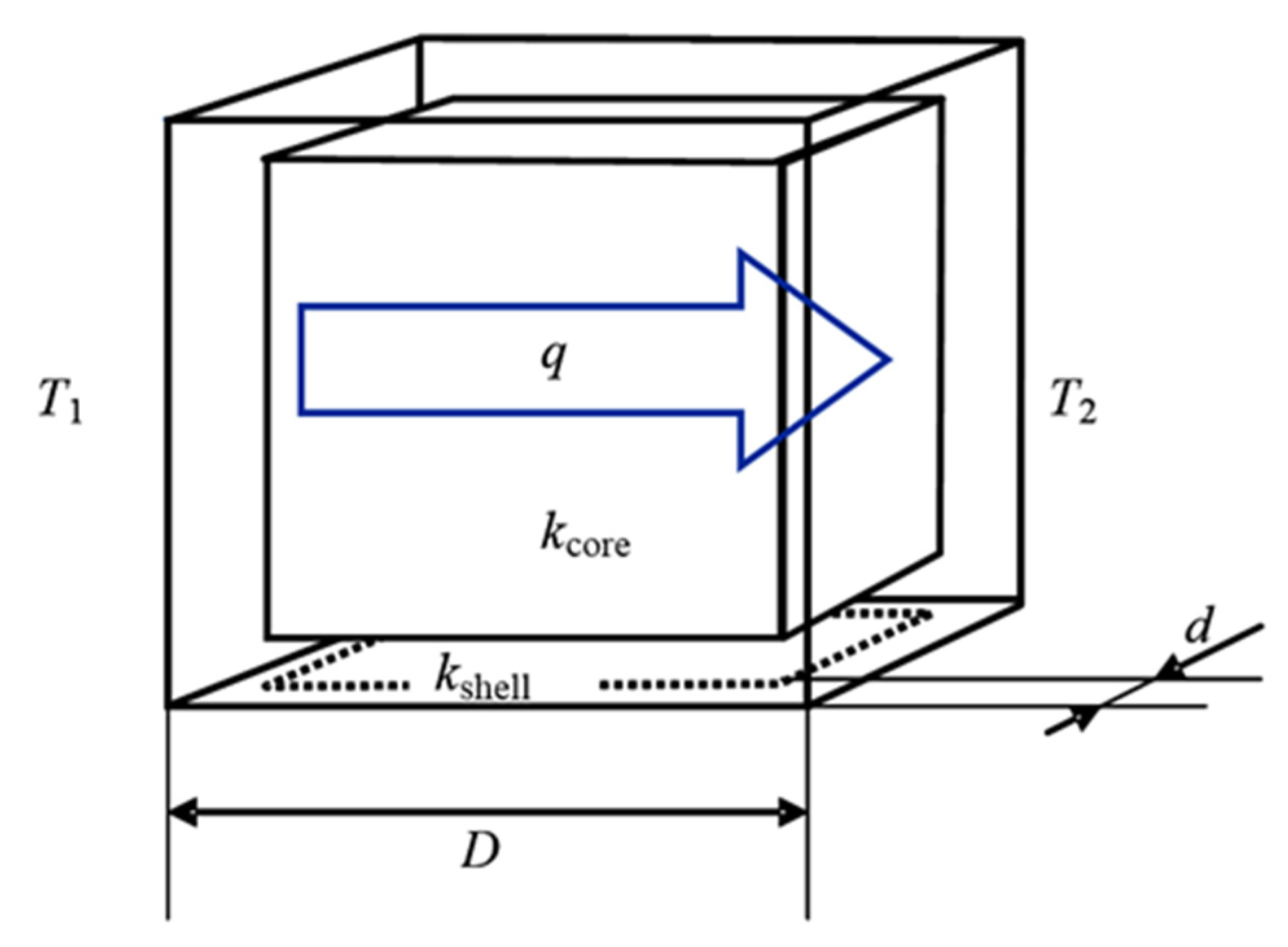
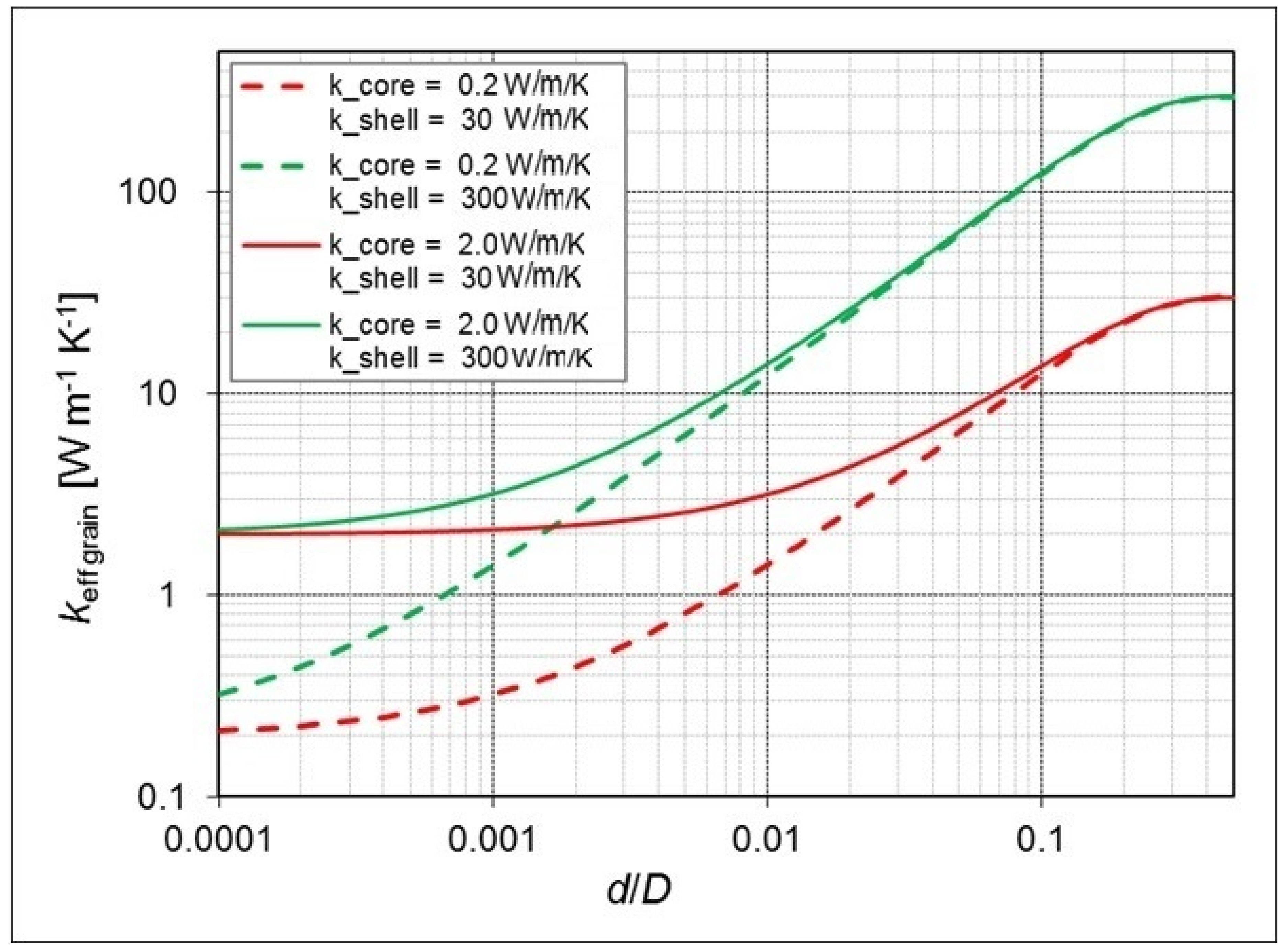




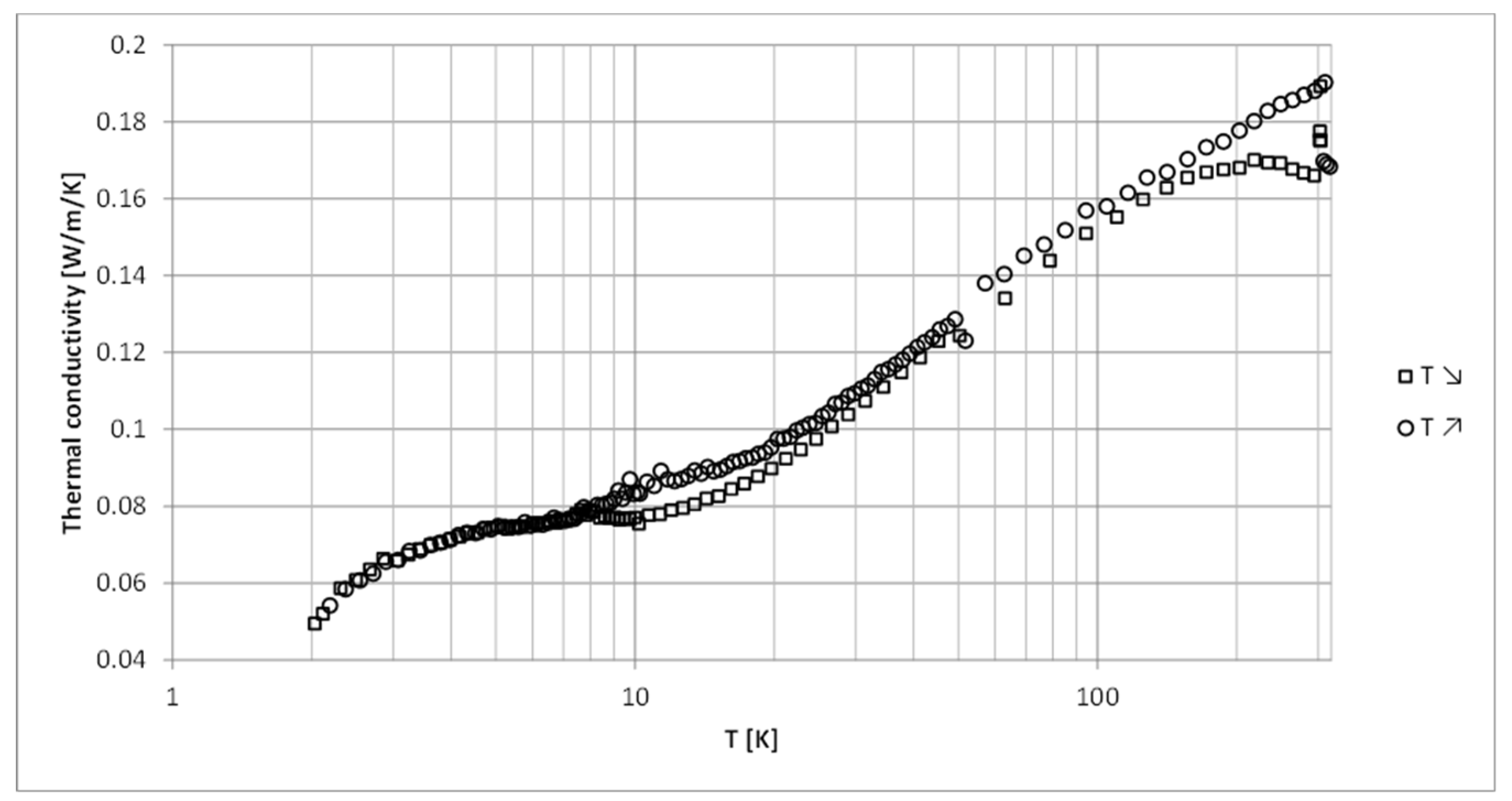

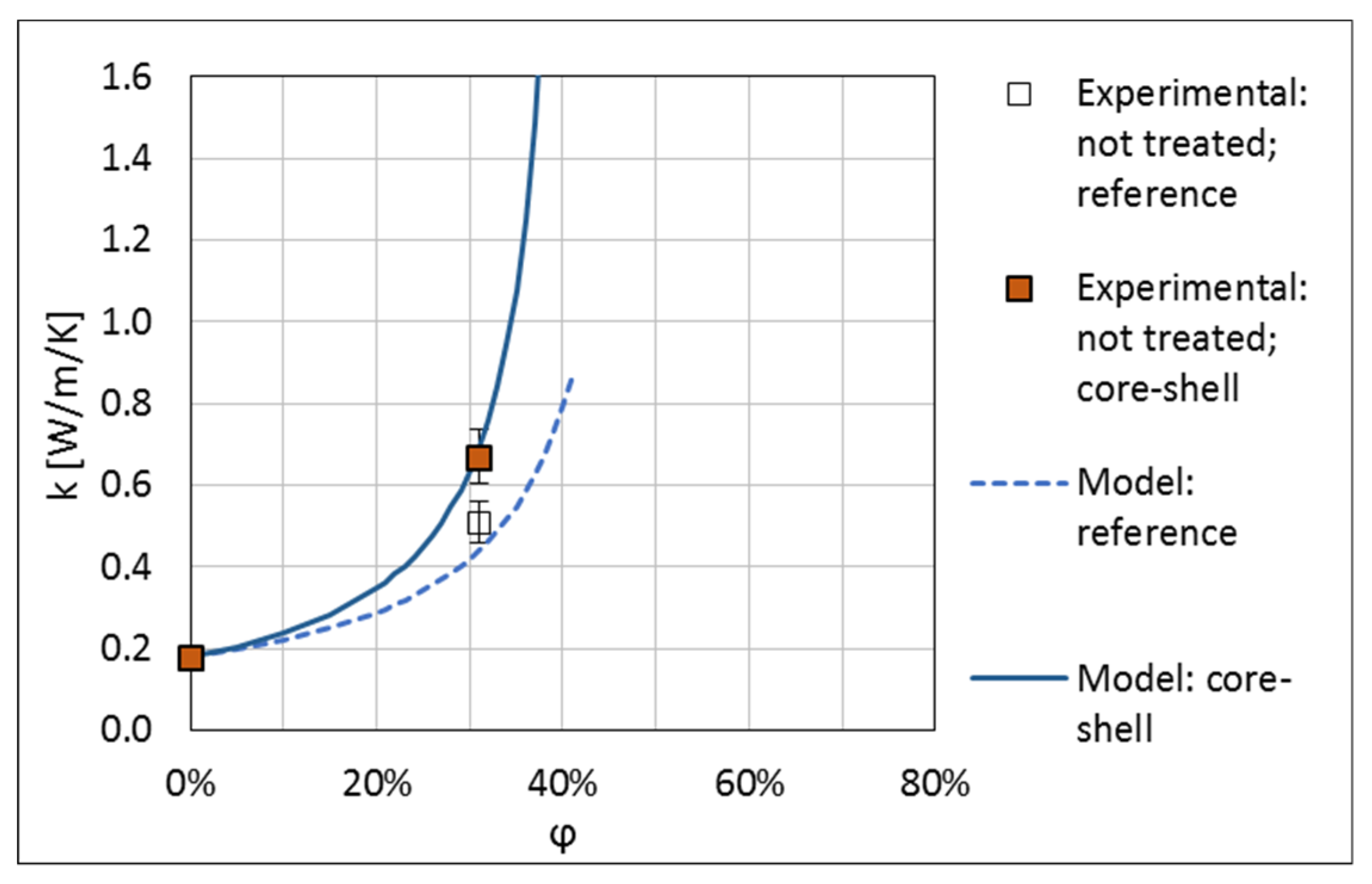
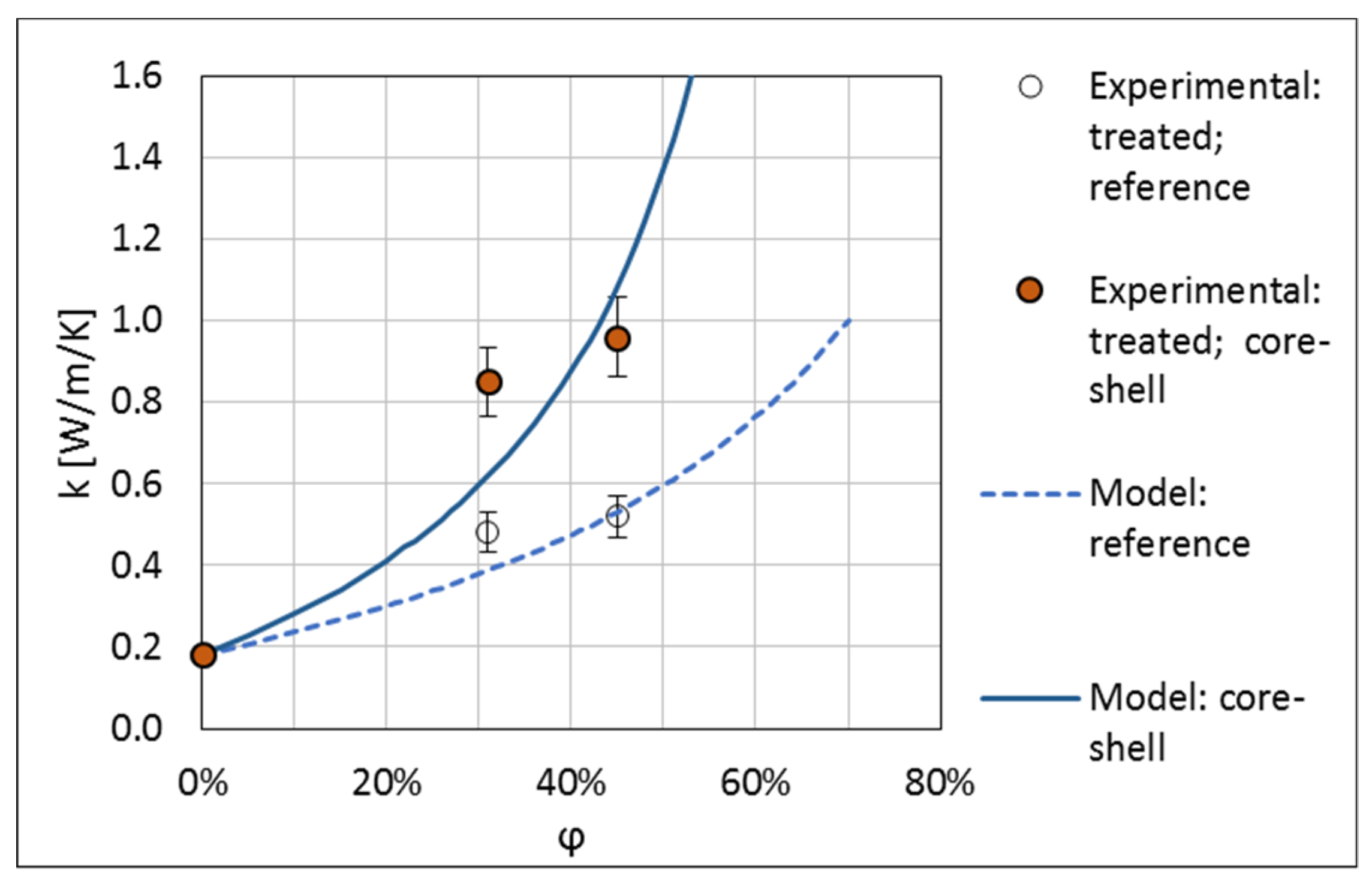
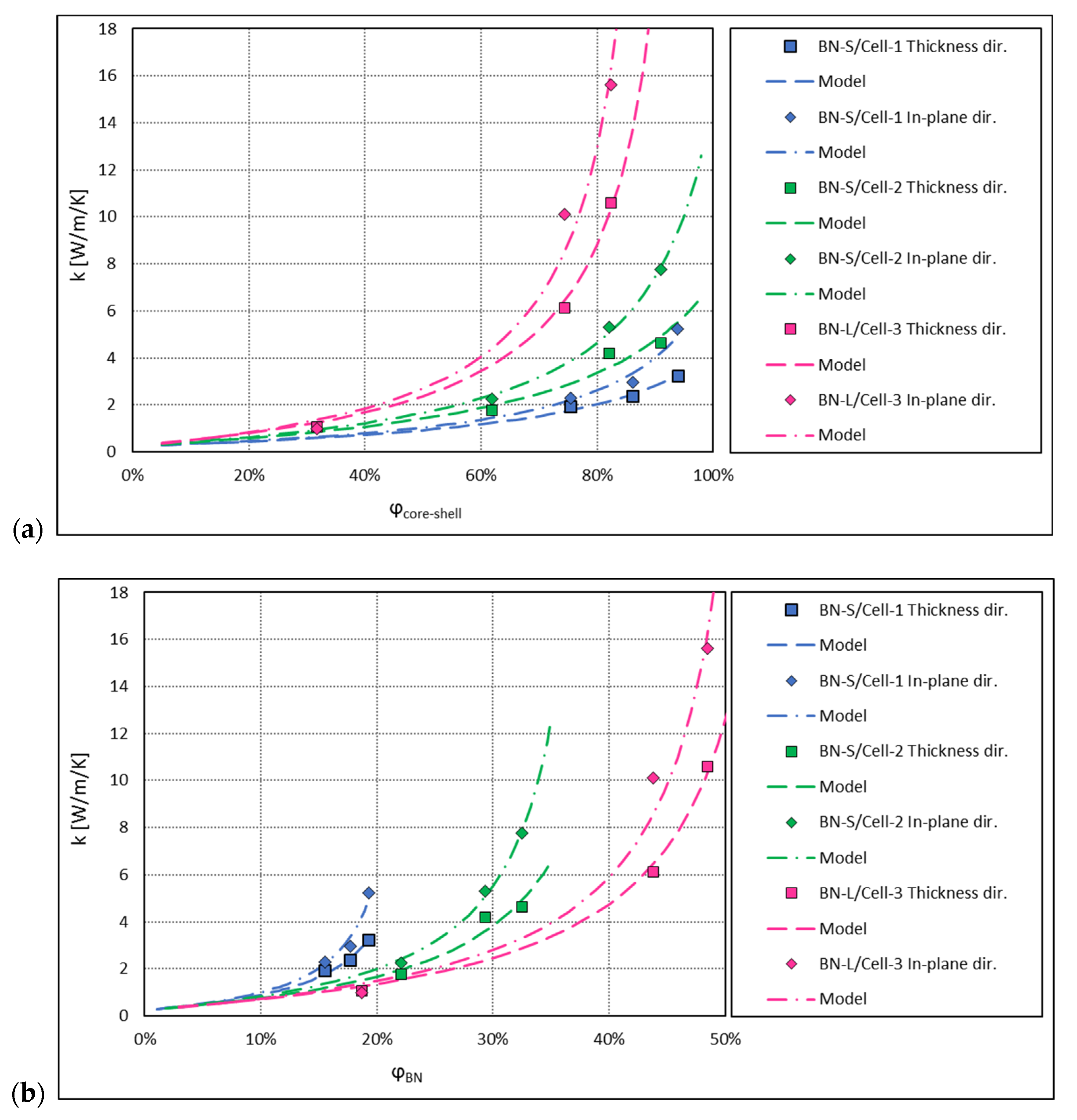

| Filler Type | Surface Treatment | Filler Content (vol.%) | Increase with Respect to Reference Filler | |
|---|---|---|---|---|
| reference | no | 31% | 0.51 | - |
| core-shell | no | 31% | 0.67 | 31% |
| reference | yes | 31% | 0.48 | - |
| 45% | 0.52 | - | ||
| core-shell | yes | 31% | 0.85 | 77% |
| 45% | 0.96 | 84% |
| Filler | A | φmax (vol.%) |
|---|---|---|
| Untreated filler | 1.50 | 42.0% |
| Silane-treated filler | 4.07 | 74.1% |
| Core-Shell Filler | Thickness Direction | In-Plane Direction | ||||
|---|---|---|---|---|---|---|
| BN-S/Cell-1 | 3.46 | 93.9% | 21.1 | 3.41 | 32.7 | 5.17 |
| BN-S/Cell-2 | 6.01 | 100% | 24.8 | 7.23 | 51.9 | 14.9 |
| BN-L/Cell-3 | 8.51 | 92.1% | 54.8 | 28.6 | 400 | 208 |
| Pristine h-BN Filler | Thickness Direction | In-Plane Direction | ||
|---|---|---|---|---|
| BN-S | 21.1 | 86.9% | 8.03 | 33.1 |
| BN-L | 18.8 | 86.9% | 11.0 | 400 |
Publisher’s Note: MDPI stays neutral with regard to jurisdictional claims in published maps and institutional affiliations. |
© 2020 by the authors. Licensee MDPI, Basel, Switzerland. This article is an open access article distributed under the terms and conditions of the Creative Commons Attribution (CC BY) license (http://creativecommons.org/licenses/by/4.0/).
Share and Cite
Czyzewski, J.; Rybak, A.; Gaska, K.; Sekula, R.; Kapusta, C. Modelling of Effective Thermal Conductivity of Composites Filled with Core-Shell Fillers. Materials 2020, 13, 5480. https://doi.org/10.3390/ma13235480
Czyzewski J, Rybak A, Gaska K, Sekula R, Kapusta C. Modelling of Effective Thermal Conductivity of Composites Filled with Core-Shell Fillers. Materials. 2020; 13(23):5480. https://doi.org/10.3390/ma13235480
Chicago/Turabian StyleCzyzewski, Jan, Andrzej Rybak, Karolina Gaska, Robert Sekula, and Czeslaw Kapusta. 2020. "Modelling of Effective Thermal Conductivity of Composites Filled with Core-Shell Fillers" Materials 13, no. 23: 5480. https://doi.org/10.3390/ma13235480
APA StyleCzyzewski, J., Rybak, A., Gaska, K., Sekula, R., & Kapusta, C. (2020). Modelling of Effective Thermal Conductivity of Composites Filled with Core-Shell Fillers. Materials, 13(23), 5480. https://doi.org/10.3390/ma13235480







